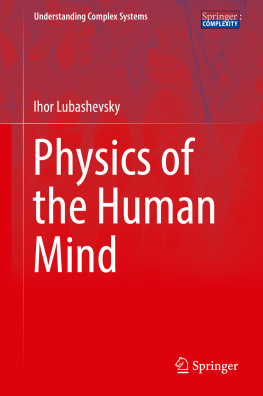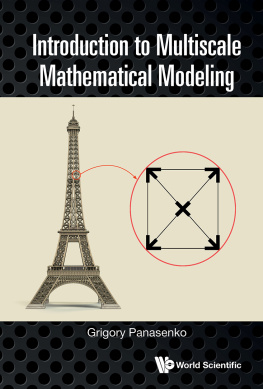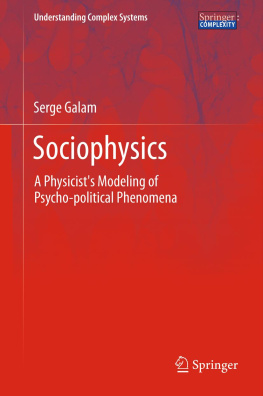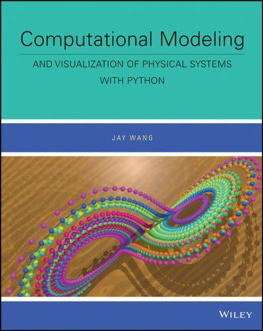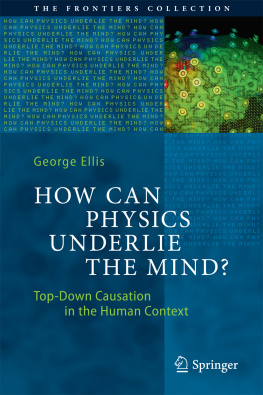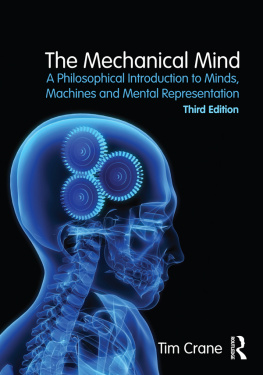1. Modeling of Human Behavior as Individual Branch of Physics and Mathematics
1.1 Can Physics Describe Human Behavior?
Rather often I met situations when my friends and colleagues being specialists in various branches of physics and mathematics became puzzled if I asked for their opinion about whether physics can describe human behavior. Some of them replied that physic is a science about the inanimate world, from elementary particles up to stars and galaxies. However it cannot say something reasonable about the behavior of people, their willingness and motives for actions. The others answered that physics cannot help humans to become happy, to find a harmony in family, or to become successful, so there is no sense to appeal to physics in our casual life.
I respect these people and their position is understandable for me. Nowadays physics involves various disciplines and for specialists in different fields to understand one another often is not easy. Knowledge acquired in one discipline and the common concepts of physics create illusion that we are able to evaluate whether an idea or theory formulated in another discipline is plausible or implausible, right or wrong. Many ideas and concepts well established now were considered previously to be wrong, naive, and even stupid.
In this section I will try to convince you, my dear reader, that physics can describe human behavior, at least some of its important aspects. However, to do this it should modify its existing formalism, to cooperate closely with sociology, psychology, physiology and other disciplines, because the object under consideration of this new physics is human beings rather than nature. New object, novel methods, old schools, and the great experience accumulated in physics in constructing models are the key to the success.
Humans on their own and social systems are really new objects for physics. Indeed, notions like memory, prediction of future, willingness, social norms are not applicable to describing the inanimate world. Oppositely, they were studied for a relatively long time in various social sciences. In its spirit physics operates with exact methods admitting the application of mathematics, thereby, usually speaking about models for some phenomena, we keep in mind their mathematical implementation. So as the first step toward elucidating which phenomena in human behavior we are going to study and what methods can be used for this, let us note a crucial for us controversy started in the late 19th by Emile Durkheim (18581917) and Max Weber (18641920). Among other classical theorists they founded sociology as an academic discipline. Their ideas, in particular, initiated up to now ongoing debate about the applicability of exact methods of analysis to studying social phenomena and human behavior. Durkheim focused his attention primarily on phenomena attributed to society at large. In Rules of the Sociological Methods (1895) he stated that social facts must always be studied according to their relation with other social facts and are more objective than the actions of the individuals composing society. Durkheims approach to social phenomena can be regarded as a rigorous scientific method similar to ones used in the natural sciences. In contrast, Weber studied mainly individuals and culture. So from his point of view subjective and individual factors play the crucial role in social phenomena. It puts fundamental obstacles to creating full-proof universal theories in social sciences and gaining objective knowledge about social phenomena. We will call this contradiction the Durkheim-Weber dilemma.
From my point of view this Durkheim-Weber dilemma can be resolved reformulating the problem. In brief, on one hand, there is a wide class of phenomena observed in individual behavior of humans as well as social systems that admit mathematical description dealing with general laws independent of individual features of humans or a particular system under consideration. It matches, in some way, Durkheims point of view. On the other hand, humans or, speaking more generally, living beings are highly different in properties from objects of the inanimate world. Therefore it is unlikely that notions and formalism developed in physics is completely applicable to describe them. I do not want to say that none of the physical concepts can be used in this case, just new notions and mathematical formalism should be developed in addition to ones inherited from physics and applied mathematics. This part corresponds to Webers opinion about the crucial role of human factors in governing various social phenomena.
Let us discuss this understanding of the Durkheim-Weber dilemma in more detail turning to rather general arguments. As far as its former part is concerned, I am pretty sure, you agree that to say something meaningful about everything is just impossible. Oppositely, any sophisticated statement about practically nothing is not interesting at all. So any deep science, on one hand, has to deal with either a wide variety of objects met in our life or something impacting upon our cognition and, in this way, affecting many aspects of our life. On the other hand, its scope is to be rather definite and must be a small part of the whole universe. Returning to our subject I would like to claim that our actions, motives, willingness, cognition, culture, moral norms, etc. make up the social reality which is highly reach and diverse in properties. So to expect that there could be created a certain mathematical discipline describing the social reality as a whole is hopeless. In order to make the description of social objects within mathematical formalism really meaningful we should, in some reasonable way, single out objects under consideration and confine ourselves to studying their properties and behavior. In this book I will try to demonstrate that we are lucky and now it is possible to find such a region in the social reality that is wide enough to be worthy of attention and admits an efficient mathematical description. You may ask me why I use the word physics bearing in mind mathematical models for human behavior. In this way I would like to emphasize that in developing mathematical models able to account for human factors we can appeal to the great experience gained in physics during the last three centuries. This experience can prompt us how to take into account only what is really necessary and not to throw out the baby with the bath water. Broadly speaking, good models should be more clever than their authors and their mathematical constructions must account for the basic properties of a given system and serve as a collection of bridges that connect with one another various features and characteristics whose relationship could be invisible to the naked eye.
Concerning the latter part in the interpretation of the Durkheim-Weber dilemma it is worthwhile to attract our attention to the fact that the great success gained in modern physics creates a certain trap for our mind. It is the general frameworks to which we usually confine our models in describing systems different from objects of the inanimate world. These frameworks are actually determined by the typical classes of mathematical models met in various branches of physics. Indeed, these models turned out to be highly efficient in describing a vast amount of physical processes and phenomena widely used in various engineering applications changed our life drastically in the last century. As a result it just has become going without saying to use physical models or their close analogies to study various phenomena in social and ecological systems. For instance, a social force model is widely used to simulate collective motion of people in crowded area, birds in flocks, fish in schools. The elements of such a system are assumed to be governed by Newtons second law relating their accelerations to the forces between them. The opinion formation, culture and language evolution are modeled using the mathematical formalism developed in the theory of phase transitions in ferromagnetic materials. However, the other side of the coin of the gained achievement in such research directions is the fact that questions as to whether a theory of social systems does fit the frameworks inherited from Newtonian mechanics and statistical physics do not attract much attention. Typical human features such as memory, making prognoses, willingness, moral an social norms, are completely beyond the paradigm of Newtonian mechanics and statistical physics. So in order to be able to allow for the human factors new concepts have to be introduced into the corresponding mathematical constructions.

